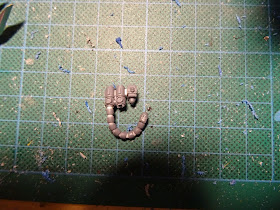Hi again,
so as mentioned already, instead of normal (dragon-like) boring wings, my Nurgle Demon prince should looked more industrial/mechanical just like the Blight Drones from Forge World. So I set off to do a small conversion building a pair of rotors, which I describe below in case you like it and want to do one yourself. I am sure that the same would also look good for an Iron Warriors Demon Prince...
But before I start, one word of CAUTION: I did not plan the conversion beforehand but just implemented new ideas on the fly. Therefore, the order below is not necessarily -- well certainly -- the best for doing this conversion. So, before you start, read the whole thing and make corresponding changes in the order...
So the idea of the rotors was to make them look "half-way" realistic, just as they could "work" in reality... ;-) Therefore, I thought a bit about the moving axis and somewhat realistic dimensions for stuff, as well as some cabling to transport the energy where needed but see yourself below.
1. First we need some kind of framing for the rotors. After looking around for quite a while, I found some scotch tape:
I unraveled all the tape and put it onto another tape roll (quite a stupid idea as it turns out as evident above, so I guess you will just have to waste the rest of the tape on the roll...).Then you have to cut the edges of the roll to get a shape as shown in the image above. I also used a fine rasp and sand paper to make the surface rough (so that it is easier to glue stuff onto it and paint it later). Obviously you need two of these "rotor frames".
2. Cut the rotor blades themselves. In my case I used thin metal sheet from a travel chess ;-) You can as well use some thin plastic cardboard but it would be good if you can bend it later slightly as shown in the pics below. They shoudl have a diameter such that they just fit tightly into the inside of the tape rolls, eh rotor frames.
3. Construction of the central cones. For these I used two rockets from the sentinel sprue. Unfortunately, I forgot to take pictures of these steps but I reconstruct explanatory images below.
I cut each of the rockets into two pieces after the first winglets as shown by the red line in the image above. In addition, I cut away the lower part below the lower winglets (see above). Then I used a rasp to form a cone from the lower part so that it looked like a rocket tip itself.
Then I drilled holes into the bottoms of the rocket parts with the same size as used for the rotors. In addition, I used a cylinder-like piece of plastic of ~5mm length with a diameter matching those of the rocket parts. I drilled a hole through these as well.
4. Now, we are ready to assemble the whole rotor-cone systems:
The black line in the image above shows a piece of wire with the right diameter to just fit into the holes. Two of these have to be assembled of course.
5. The next step is to glue these rotor/cone systems into the rotor frames as sketched below.
6. Connectors from cones to frame. For this step I used some thin metal strip that I found in my bits box. However, thin plastic card should be as fine.
I cut twelve pieces in total, three for each side of each frame. I glued them with super glue between the cone and the frame in angles of 60 degrees.
7. Mounting of the rotors. To connect the rotor frames to the rest of the model, I used several parts from 40K vehicles from my bits box:
Unfortunately, I can not say where the next piece is from but it should be easy to find or build a similar part.
I used a rounded rasp to connect the piece well to the round surface of the frame.
I modified the parts in the following way.
8. Gluing the rotor frames to the mounting and both to the model.
The following images show the positioning of the rotors.
9. Some details and generator backpack.
This part is from Robogear.
Energy cable connectors between generator and rotors (from the Sentinel sprue).
10. Details of the rotor frame. Now was when I realised that I wanted to add more details to the rotor frame, so I unmounted the rotors again. Thus, you probably want to do these steps before gluing everything to the model, i.e. before step 7.
First I added some narrow guitar strings from the cone to the cabling on the outside of the rotor frame. For this, you have to drill suitable holes through the tape roll. In addition, I used some sprue frames to fill out the part of the tape roll at the mounting (see images below). This was done on the upper and lower side of both rotors.
Next, I added some spikes :
Finally, I added some cables in the outer ring of the rotor frame:
Then I painted the inside of the outer ring black...
... before I glue fine mesh ontop.
11. "Ageing" of the rotor frame, aka Nurgle's rot. Before gluing (back) to the model, I carefully drilled many holes with different diameters into the rotor frames:
12. Final step: Armour opening of the power armour around the rotor mounts. To blend in the connection between the model and the rotors I used Green Stuff.
After priming:








































That's pretty sweet, and an ingenious conversion job.
ReplyDeleteThis is great going to be doing something similar thanks for the inspiration great job! ��
ReplyDelete